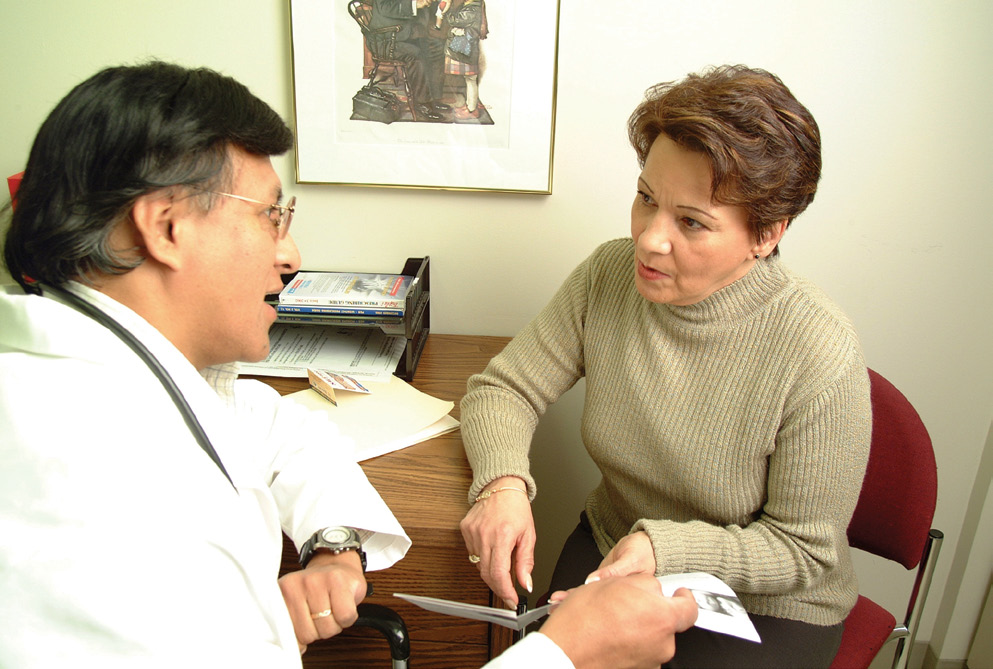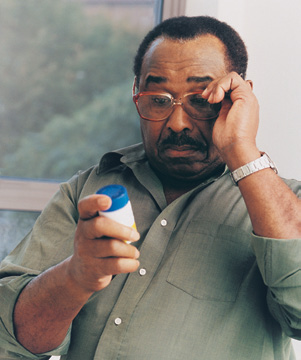
Support for People With Cancer
Pain Control
National Cancer Institute
U.S. DEPARTMENT
OF HEALTH AND
HUMAN SERVICES
National Institutes
of Health


For more information . . .
This booklet is only one of many free booklets for people with cancer.
Here are some others you and your loved ones may find useful:
• Biological Therapy: Treatments That Use Your Immune System To Fight Cancer
• Chemotherapy and You
• Coping With Advanced Cancer
• Eating Hints for Cancer Patients
• If You Have Cancer: What You Should Know About Clinical Trials
• Radiation Therapy and You
• Taking Time
• Thinking About Complementary and Alternative Medicine
• When Cancer Returns
• When Someone You Love Is Being Treated for Cancer
• When Someone You Love Has Advanced Cancer
• When Your Parent Has Cancer
These free booklets are available from the National Cancer Institute (NCI).
NCI is a Federal agency that is part of the National Institutes of Health.
To order or download, call 1-800-4-CANCER (1-800-422-6237) or visit http://www.cancer.gov. (See page 34 of this booklet for more resources.) For information about your specific type of cancer, see NCI’s Physican Data Query (PDQ®) database at http://www.cancer.gov. From the home page, it is listed under “Cancer Topics.”
Product or brand names that appear in this booklet are for example
only. The U.S. Government does not endorse any specific product or
brand. If products or brands are not mentioned, it does not mean or
imply that they are not satisfactory.

Pain Control
Support for People With Cancer
Cancer pain can be managed.
Having cancer doesn’t mean that you’ll have pain. But if you do, you can manage most of your pain with medicine and other treatments.
This booklet will show you how to work with your doctors, nurses, and others to find the best way to control your pain. It will discuss causes of pain, medicines, how to talk to your doctor, and other topics that may help you.
Your “health care team” can help you manage cancer pain.
In this booklet, your “health care team” can mean any of the professionals you see as part of your medical care. These may include your oncologist, your family doctor, nurses, physical therapists, pharmacists, oncology social workers, clergy members, and others.
Read what you need.
Use this booklet in the way that works best for you. You may read it from front to back. Or you may want to read different parts as you need them.
There is a list of resources toward the end of the booklet. There is also a page where you can write down notes and keep track of the medicines you’re taking. This section also includes a sample pain control record.
Words in bold are explained at the end of the booklet in “Words To Know.” They include terms you might hear in doctors’ offices or hospitals.




Table of Contents
1. What You Should Know About Treating Cancer Pain .............. 1
2. Types and Causes of Cancer Pain .............................................. 3
3. Talking About Your Pain ............................................................ 5
4. Your Pain Control Plan .............................................................. 9
5. Medicines To Treat Cancer Pain ...............................................11
Questions to ask your health care team about your
pain medicine: ................................................................................... 18
6. Medicine Tolerance and Addiction .......................................... 20
7. Other Ways To Control Pain ................................................... 22
8. Your Feelings and Pain ............................................................. 27
9. Financial Issues ........................................................................ 30
Reflection ....................................................................................... 33
Resources ...................................................................................... 34
Pain Control Record ...................................................................... 37
How to Use Imagery ...................................................................... 39
Words To Know ............................................................................. 41
Before You Go to the Pharmacy .................................................... 44



“I thought that I had to live with the pain, but
it got to the point where I just couldn’t handle
it anymore. My doctor changed my medicines,
which seems to be working for me. I’m not
saying that I’m always pain free, but it’s a lot
better now.” —John

C H A P T E R 1
What You Should Know About
Treating Cancer Pain
You don’t have to accept pain.
People who have cancer don’t always have pain. Everyone is different. But if you do have cancer pain, you should know that you don’t have to accept it. Cancer pain can almost always be relieved.
The key messages we want you to learn from this booklet are:
■
■ Your pain can be managed.
■
■ Controlling pain is part of your cancer treatment.
■
■ Talking openly with your doctor and health care team will help them manage your pain.
■
■ The best way to control pain is to stop it from starting or keep it from getting worse.
■
■ There are many different medicines to control pain. Everyone’s pain control plan is different.
■
■ Keeping a record of your pain will help create the best pain control plan for you.
■
■ People who take cancer pain medicines as prescribed rarely become addicted to them.
■
■ Your body does not become immune to pain medicine. Stronger medicines should not be saved for “later.”
1


Palliative care and pain specialists can help.
Cancer pain can be reduced so that you can enjoy your normal routines and sleep better. It may help to talk with a palliative care or pain specialist. These may be oncologists, anesthesiologists, neurologists, surgeons, other doctors, nurses, or pharmacists. If you have a pain control team, it may also include psychologists and social workers.
Pain and palliative care specialists are experts in pain control. Palliative care specialists treat the symptoms, side effects, and emotional problems of both cancer and its treatment. They will work with you to find the best way to manage your pain.
Ask your doctor or nurse to suggest someone. Or contact one of the following for help finding a specialist in your area:
■
■ Cancer center
■
■ Your local hospital or medical center
■
■ Your primary care provider
■
■ People who belong to pain support groups in your area
■
■ The Center to Advance Palliative Care, http://www.getpalliativecare.org
(for lists of providers in each state)
When cancer pain is not treated
properly, you may be:
■
■ Tired
■
■ Depressed
When cancer pain is managed
■
■ Angry
properly, you can:
■
■ Worried
■
■ Enjoy being active
■
■ Lonely
■
■ Sleep better
■
■ Stressed
■
■ Enjoy family and friends
■
■ Improve your appetite
■
■ Enjoy sexual intimacy
■
■ Prevent depression
2

C H A P T E R 2
Types and Causes of Cancer Pain
Cancer pain can range from mild to very severe. Some days it can be worse than others. It can be caused by the cancer itself, the treatment, or both.
You may also have pain that has nothing to do with your cancer. Some people have other health issues or headaches and muscle strains. But always check with your doctor before taking any over-the-counter medicine to relieve everyday aches and pains. This will help ensure that there will be no interactions with other drugs or safety concerns to know about.
Different types of pain
Here are the common terms used to describe different types of pain:
■
■ Acute pain ranges from mild to severe. It comes on quickly and lasts a short time.
■
■ Chronic pain ranges from mild to severe. It either won’t go away or comes back often.
■
■ Breakthrough pain is an intense rise in pain that occurs suddenly or is felt for a short time. It can occur by itself or in relation to a certain activity. It may happen several times a day, even when you’re taking the right dose of medicine. For example, it may happen as the current dose of your medicine is wearing off.
What causes cancer pain?
Cancer and its treatment cause most cancer pain. Major causes of pain include:
■
■ Pain from medical tests. Some methods used to diagnose cancer or see how well treatment is working are painful. Examples may be a biopsy, spinal tap, or bone marrow test. If you are told you need the procedure, don’t let concerns about pain stop you from having it done. Talk with your doctor ahead of time about what will be done to lessen any pain you may have.
■■ Pain from a tumor. If the cancer grows bigger or spreads, it can cause pain by pressing on the tissues around it. For example, a tumor can cause pain if it presses on bones, nerves, the spinal cord, or body organs.
3
■
■ Spinal cord compression. When a tumor spreads to the spine, it can press on the spinal cord and cause spinal cord compression. The first sign of this is often back or neck pain, or both. Coughing, sneezing, or other motions may make it worse.
■■ Pain from treatment. Chemotherapy, radiation therapy, surgery, and other treatments may cause pain for some people. Some examples of pain from treatment are:
• Neuropathic pain. This is pain that may occur if treatment damages the nerves. The pain is often burning, sharp, or shooting. The cancer itself can also cause this kind of pain.
• Phantom pain. You may still feel pain or other discomfort coming from a body part that has been removed by surgery. Doctors aren’t sure why this happens, but it’s real.
How much pain you feel depends on different things. These include where the cancer is in your body, what kind of damage it is causing, and how you experience the pain in your body. Everyone is different.
Call your doctors right away
Listen to your body. If you notice that everyday actions,
such as coughing, sneezing, moving, walking, or standing,
suddenly cause new pain or your pain to get worse, tell your doctors right away. Also let them know if you have unusual rashes or bowel or bladder changes.
4

C H A P T E R 3
Talking About Your Pain
Pain control is part of treatment. Talking openly is key.
“At first I tried to be brave. Now I realize that the only way to handle my pain is to be open and honest about it with my health care team. It’s the only way I can stay on top of it and keep it under control.” —Janie Controlling pain is a key part of your overall cancer treatment. The most important member of the team is you. You’re the only one who knows what your pain feels like. Talking about pain is important. It gives your health care team the feedback they need to help you feel better.
Some people with cancer don’t want to talk about their pain. They think that they’ll distract their doctors from working on ways to help treat their cancer. Or they worry that they won’t be seen as “good” patients. They also worry that they won’t be able to afford pain medicine. As a result, people sometimes get so used to living with their pain that they forget what it’s like to live without it.
But your health care team needs to know details about your pain and whether it’s getting worse. This helps them understand how the cancer and its treatment are affecting your body. And it helps them figure out how to best control the pain.
Try to talk openly about any other medical problems and fears you have. And if money worries are stopping you, be sure to read the Financial Issues section starting on page 30 of this booklet. There may be ways to help you get the medicine you need.
Tell your health care team if you’re:
■
■ Taking any medicine to treat other health problems
■
■ Taking more or less of the pain medicine than prescribed
■
■ Allergic to certain drugs
■
■ Using any over-the-counter medicines, home remedies, or herbal or alternative therapies
This information could affect the pain control plan your doctor suggests for you.
If you feel uneasy talking about your pain, bring a family member or friend to speak for you. Or let your loved one take notes and ask questions. Remember, open communication between you, your loved ones, and your health care team will lead to better pain control.
5


Talking about your pain.
The first step in getting your pain under control is talking honestly about it. Try to talk with your health care team and your loved ones about what you are feeling. This means telling them:
■
■ Where you have pain
■
■ What it feels like (sharp, dull, throbbing, constant, burning, or shooting)
■
■ How strong your pain is
■
■ How long it lasts
■
■ What lessens your pain or makes it worse
■
■ When it happens (what time of day, what you’re doing, and what’s going on)
■
■ If it gets in the way of daily activities
Describe and rate your pain.
You will be asked to describe and rate your pain. This provides a way to assess your pain threshold and measure how well your pain control plan is working.
Your doctor may ask you to describe your pain in a number of ways. A pain scale is the most common way. The scale uses the numbers 0 to 10, where 0 is no pain, and 10 is the worst. You can also use words to describe pain, like pinching, stinging, or aching. Some doctors show their patients a series of faces and ask them to point to the face that best describes how they feel.
No matter how you or your doctor keep track of your pain, make sure that you do it the same way each time. You also need to talk about any new pain you feel.
It may help to keep a record of your pain. See the chart on page 37 for an example.
Some people use a pain diary or journal. Others create a list or a computer spreadsheet. Choose the way that works best for you.
Your record could list:
■
■ When you take pain medicine
■
■ Name and dose of the medicine
you’re taking
■
■ Any side effects you have
■
■ How much the medicine lowers the
pain level
■
■ How long the pain medicine works
■
■ Other pain relief methods you use
to control your pain
6




■
■ Any activity that is affected by pain, or makes it better or worse
■
■ Things that you can’t do at all because of the pain
Share your record with your health care team. It can help them figure out how helpful your pain medicines are, or if they need to change your pain control plan.
Here are some ways your health care team may ask you
to describe or rate your pain:
0
1
2
3
4
5
6
7
8
9
10
No
Moderate
Worst
Pain
Pain
Possible Pain
No
Mild
Moderate
Severe
Very
Worst
Pain
Pain
Pain
Pain
Severe
Possible
Pain
Pain
No
Pain As Bad As It
Pain
Could Possibly Be
0
2
4
6
8
10
No hurt
Hurts a
Hurts a
Hurts
Hurts a
Hurts
little bit
little more
even more
whole lot
worst
0–10 Numeric Pain Intensity Scale, Simple Descriptive Pain Intensity Scale, and Visual Analog Scale (VAS): Acute Pain Management Guideline Panel. Acute Pain Management in Adults: Operative Procedures. Quick Reference Guide for Clinicians AHCPR Pub. No. 92-0019. Rockville, MD: Agency for Health Care Policy and Research, Public Health Service, U.S. Department of Health and Human Services.
“Faces” Pain Scale adapted with permission from Hockenberry MJ, Wilson D, Winkelstein ML: Wong’s Essentials of Pediatric Nursing, ed. 7, St. Louis, 2005, p. 1259. Used with permission. Copyright, Mosby.
7


Share your beliefs.
Some people don’t want to take medicine, even when it’s prescribed by the doctor.
Taking it may be against religious or cultural beliefs. Or there may be other personal reasons why someone won’t take medicine. If you feel any of these ways about pain medicine, it’s important to share your views with your health care team. If you prefer, ask a friend or family member to share them for you. Talking openly about your beliefs will help your health care team find a plan that works best for you.
“It makes sense. If you don’t
tell someone about your pain,
then no one can help you! And
the pain won’t go away by
itself.” — Joe
8

C H A P T E R 4
Your Pain Control Plan
“It took a few visits to my health care team to get my pain under control. But by trying different medicines and doses, I now have a pain plan that works for me.” —Michelle
Make your pain control plan work for you.
Your pain control plan will be designed for you and your body. Everyone has a different pain control plan. Even if you have the same type of cancer as someone else, your plan may be different.
Take your pain medicine dose on schedule to keep the pain from starting or getting worse. This is one of the best ways to stay on top of your pain. Don’t skip doses.
Once you feel pain, it’s harder to control and may take longer to get better.
Here are some other things you can do:
■
■ Bring your list of medicines to each visit.
■
■ If you are seeing more than one doctor, make sure each one sees your list of medicines, especially if he or she is going to change or prescribe medicine.
■
■ Never take someone else’s medicine. What helped a friend or relative may not help you. Do not get medicine from other countries or the Internet without telling your doctor.
■
■ Don’t wait for the pain to get worse.
■
■ Ask your doctor to change your pain control plan if it isn’t working.
The best way to control pain is to stop it before it starts or prevent it from getting worse.
Don’t wait until the pain gets bad or unbearable before taking your medicine. Pain is easier to control when it’s mild. And you need to take pain medicine often enough to stay ahead of your pain. Follow the dose schedule your doctor gives you. Don’t try to
“hold off” between doses. If you wait:
■
■ Your pain could get worse.
■
■ It may take longer for the pain to get better or go away.
■
■ You may need larger doses to bring the pain under control.
9
Keep a list of all your medicines.
Make a list of all the medicines you are taking. If you need to, ask a member of your family or health care team to help you. Bring this list of medicines to each visit. You can take most pain medicines with other prescription drugs. But your health care team needs to know what you take and when. Tell them each drug you are taking, no matter how harmless you think it might be. Eve




























